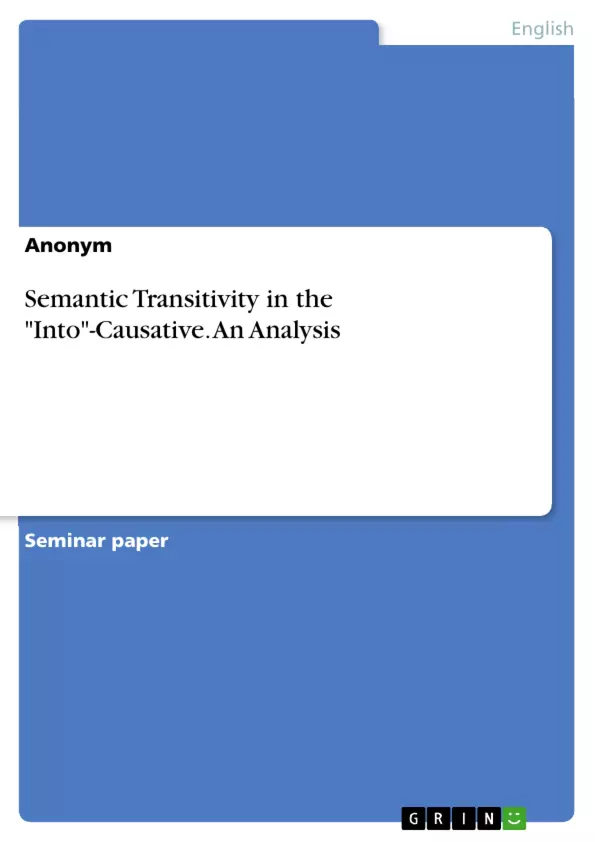This essay discusses the into-causative, a rather modern subject in linguistics, and its semantic transitivity. The author argues that by using Hopper and Thompson’s transitivity criteria it is not only possible to analyse the degree of transitivity of the into-causative but also to get insights in which contexts certain transitivity patterns occur.
In order to classify his findings, the author first examines these constructions with respect to Hopper and Thompson’s features of ‘Mode’ and ‘Affirmation’. Afterwards, these features are further classified, and it is shown whether there are features that attract each other, also including the aspect of reflexiveness and voice. As a last step he illustrates the degree of semantic transitivity of the into-causative, using the features analysed in this study.
Inhaltsverzeichnis (Table of Contents)
- Introduction.
- Semantic Transitivity based on Hopper and Thompson (1980).
- Transitivity Analyses on other Causative Constructions
- Lexical Approaches to the into-Causative
- Data and Method.
- Analysis and Results.
- Realis vs Irrealis into-Causatives.
- Occurrence of Irrealis features
- Co-Occurrences of Irrealis Features.
- Co-Occurrences of Negation + Modal +
- Overall Co-Occurrences of Detransitivisation Features...
- Conclusion.
Zielsetzung und Themenschwerpunkte (Objectives and Key Themes)
This paper investigates the semantic properties of the into-causative construction, analyzing the degree of semantic transitivity within its context. The focus is on understanding how the into-causative, despite its syntactic transitivity, can exhibit low transitivity on a semantic level.
- Examining the degree of semantic transitivity in into-causative constructions.
- Analyzing the influence of Hopper and Thompson's transitivity criteria on the into-causative.
- Investigating the occurrence of specific transitivity patterns in different contexts.
- Exploring the relationship between semantic transitivity and features like modality, negation, and reflexiveness.
- Identifying potential connections between causative event types and the prevalence of irrealis mode in into-causatives.
Zusammenfassung der Kapitel (Chapter Summaries)
The introduction defines the scope of the study and introduces the into-causative construction, highlighting its recent emergence and research potential. The paper focuses on examining the semantic transitivity of the into-causative, using Hopper and Thompson's model as a framework. The concept of transitivity and its application to causative constructions is further explored in Chapter 3, examining previous studies on other causative constructions and their findings regarding transitivity criteria.
Chapter 4 delves into lexical approaches to the into-causative, highlighting previous research on the lexical variation within this construction. These studies, focusing on cause predicates and collexemes, provide valuable insights for understanding the semantic transitivity patterns explored in this paper.
The paper proceeds with the analysis of data and results, exploring the into-causative construction in detail. The focus lies on examining the features of modality, negation, reflexiveness, and voice within this construction, as well as their relationship to semantic transitivity.
Schlüsselwörter (Keywords)
This study focuses on the semantic transitivity of the into-causative construction. It investigates the application of Hopper and Thompson's transitivity criteria to this construction, analyzing the role of features like modality, negation, and reflexiveness. The paper also explores the relationship between causative event types and the prevalence of irrealis mode in into-causatives, contributing to a deeper understanding of the semantic complexity of this construction.
- Quote paper
- Anonym (Author), 2019, Semantic Transitivity in the "Into"-Causative. An Analysis, Munich, GRIN Verlag, https://www.grin.com/document/1361406



